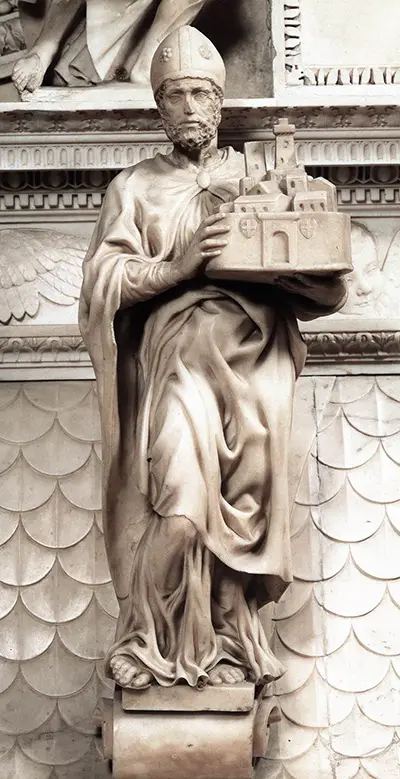The Basilica of San Domenico is one of the major churches of Bologna and it contains the remains of Saint Domenic, who founded the order of the Dominicans.
Sculpted between 1494 and 1495, the statue of St Petronius was made completely out of marble. The statue’s height is 64 cm and accompanies a base at the bottom. The statue encompasses a lot of deep carvings that help reveal a lot of detail and shadowing.
These miraculous deep carvings are particularly prominent in his beard, eye sockets, robe, and in the void area underneath his arms that are at chest level. The statue also depicts a certain level of animation. If the viewer glances at St Petronius’s feet, one can see that the right foot is making a stride, so as to suggest the saint’s active work in Bologna or otherwise.
Michelangelo’s St Petronius is widely received as a work of kinetic art. Kinetic art is a sort of artistic medium that tries to depict motion or movement depending on the viewer’s stance etc.
If one considers the stride depicted in St Petronius’s step, along with the flowing creases and textures in his robe, it looks as if the representation of St Petronius himself is in fact moving. This renders Michelangelo’s St Petronius as an exceptional example of Italian Renaissance kinetic art.
When it comes to Renaissance sculpting, Michelangelo was simply put one of the best. He was well known and renowned for his influence in developing Western art into what it is today. Michelangelo was born in 1475 and died in 1564. During his time on this Earth, he was considered to be the greatest artist of his lifetime. Michelangelo was a painter, architect, poet, and sculptor, but he was mostly known for his work in the latter field. He was famous for his statues in particular, as he was able to usher in a new era of detailing hardly seen before on the European continent.
St Petronius, although not his most famous piece, is a wonderful piece of art that, like many other works of Michelangelo, tells an interesting story regarding a particular character. Little is known about this bishop in particular, other than the fact that he ended up converting to Christianity and became the bishop of Bologna shortly thereafter. In Michelangelo’s statue, you can see St Petronius holding a model of Bologna in his hands.
If you enjoy the work of Michelangelo, you might consider checking out a few other amazing and world-renowned statues such as: David, Pieta, Bacchus, and Moses. David, arguably the most famous statue in the world, depicts the greatness of man in a brilliant white marble that was so heavily used during the Italian Renaissance. Pieta depicts the body of Jesus on the lap of his mother, Mary, after Jesus’s crucifixion.
Such a depiction of Jesus with his Mother in this nature was unprecedented in Italy during its erection. The statues of Pieta and St Petronius are both similar in that they share Michelangelo’s famous deep carving technique that gives true detail to curves and shadowy areas.
Bacchus, the Greek god of wine, is seen here standing as to suggest drunkenness as he holds a cup of wine in one hand, and a bunch of grapes eagerly being plucked by a faun in the other. When Michelangelo created Moses, he did so in a way that suggests he was able to transform the chisel into a brush, as his treatment of the marble was remarkably smooth and refined. Perhaps somewhat controversial, this particular rendering of the biblical figure is adorned with horns, as is a common convention within Latin Christianity.


